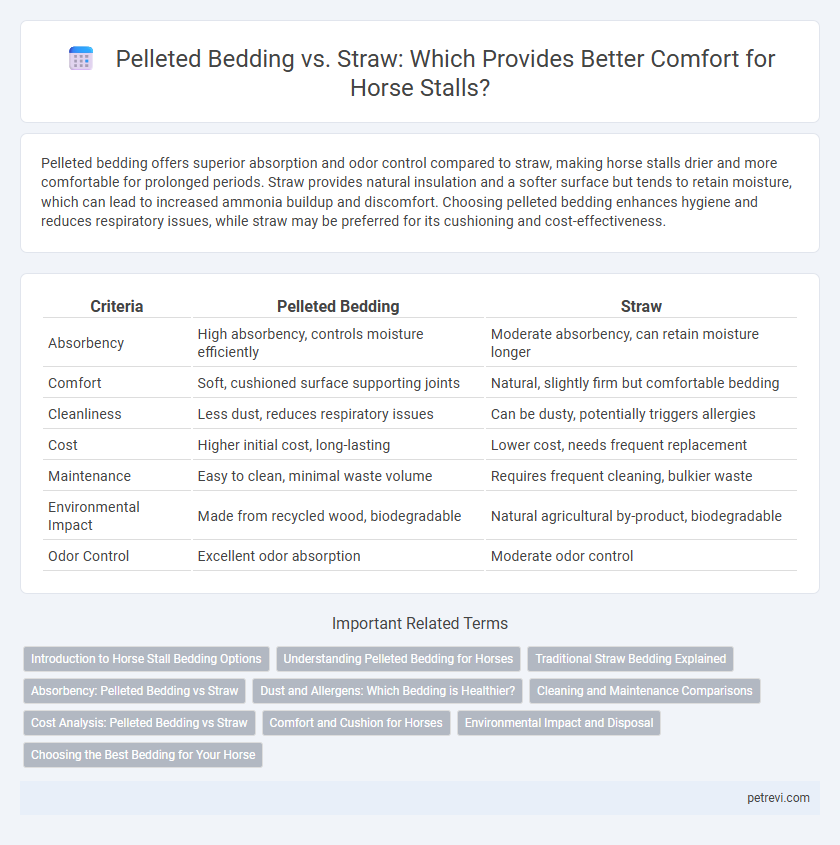Pelleted bedding offers superior absorption and odor control compared to straw, making horse stalls drier and more comfortable for prolonged periods. Straw provides natural insulation and a softer surface but tends to retain moisture, which can lead to increased ammonia buildup and discomfort. Choosing pelleted bedding enhances hygiene and reduces respiratory issues, while straw may be preferred for its cushioning and cost-effectiveness.
Table of Comparison
| Criteria | Pelleted Bedding | Straw |
|---|---|---|
| Absorbency | High absorbency, controls moisture efficiently | Moderate absorbency, can retain moisture longer |
| Comfort | Soft, cushioned surface supporting joints | Natural, slightly firm but comfortable bedding |
| Cleanliness | Less dust, reduces respiratory issues | Can be dusty, potentially triggers allergies |
| Cost | Higher initial cost, long-lasting | Lower cost, needs frequent replacement |
| Maintenance | Easy to clean, minimal waste volume | Requires frequent cleaning, bulkier waste |
| Environmental Impact | Made from recycled wood, biodegradable | Natural agricultural by-product, biodegradable |
| Odor Control | Excellent odor absorption | Moderate odor control |
Introduction to Horse Stall Bedding Options
Pelleted bedding and straw are popular choices for horse stall comfort, each offering distinct benefits. Pelleted bedding, made from compressed wood fibers, provides excellent absorbency and minimizes dust, promoting a cleaner environment. Straw, a traditional option, offers natural insulation and cushioning, though it may require more frequent cleaning to maintain optimal stall hygiene.
Understanding Pelleted Bedding for Horses
Pelleted bedding for horses is made from compressed wood fibers, offering high absorbency and excellent odor control compared to traditional straw. This type of bedding provides superior cushioning, reducing the risk of injuries and promoting better joint health for horses during rest. Its low dust content and easy maintenance contribute to a cleaner, healthier stall environment that supports respiratory wellness.
Traditional Straw Bedding Explained
Traditional straw bedding for horse stalls provides excellent insulation and natural cushioning, promoting a comfortable resting area that absorbs moisture effectively. Its fibrous texture allows horses to nest and rearrange bedding, enhancing behavioral comfort and stall cleanliness. Despite being less absorbent than pelleted bedding, straw remains a popular choice due to its biodegradability and cost-effectiveness in equine environments.
Absorbency: Pelleted Bedding vs Straw
Pelleted bedding outperforms straw in absorbency, effectively soaking up moisture and keeping the horse stall dry and clean. Straw tends to retain moisture, which can lead to damp conditions and increase the risk of bacterial growth and hoof problems. High absorbency in pelleted bedding enhances stall hygiene, reduces odors, and promotes better respiratory health for horses.
Dust and Allergens: Which Bedding is Healthier?
Pelleted bedding produces significantly less dust compared to straw, reducing airborne allergens that can trigger respiratory issues in horses. Straw often contains mold spores and dust particles that exacerbate conditions such as heaves or allergic rhinitis. Choosing low-dust pelleted bedding contributes to a healthier stall environment by minimizing exposure to respiratory irritants.
Cleaning and Maintenance Comparisons
Pelleted bedding offers superior moisture absorption and compacts less than straw, making stall cleaning faster and more efficient for horse owners. Straw requires more frequent removal due to its tendency to trap waste and retain moisture, increasing labor and maintenance costs. The densified pellets also reduce dust levels and odor, promoting a healthier environment compared to traditional straw bedding.
Cost Analysis: Pelleted Bedding vs Straw
Pelleted bedding typically costs more upfront than straw but offers greater longevity and absorbency, reducing the frequency of stall cleaning and bedding replacement, which can lower overall expenses. Straw is generally cheaper per bale but requires more volume to achieve similar comfort and absorption, leading to higher labor and disposal costs over time. When analyzing long-term expenses, pelleted bedding often proves more cost-effective due to its efficient use and enhanced stall hygiene.
Comfort and Cushion for Horses
Pelleted bedding provides superior cushioning and moisture absorption, reducing pressure points and promoting joint health for horses. Straw, while traditional, offers less shock absorption and can become compacted, leading to uneven support in stalls. Optimizing stall comfort with pelleted bedding enhances horse welfare by maintaining dryness and minimizing the risk of pressure sores.
Environmental Impact and Disposal
Pelleted bedding offers superior environmental benefits compared to straw, as it is often made from compressed recycled wood or paper, reducing landfill waste and promoting sustainable resource use. Its dense composition allows for easier composting and less frequent stall cleaning due to high absorbency, minimizing ammonia emissions harmful to both horses and handlers. Straw, while natural, tends to decompose slower and generate more waste volume, leading to increased disposal challenges and potential environmental strain when not managed properly.
Choosing the Best Bedding for Your Horse
Pelleted bedding offers superior absorbency and dust control compared to traditional straw, promoting a cleaner and healthier stall environment for horses. Straw provides natural insulation and is often preferred for its cushioning properties, but it requires more frequent maintenance due to lower moisture absorption. Choosing the best bedding depends on factors like your horse's respiratory sensitivity, budget, and stall cleaning routine to maximize comfort and hygiene.
Pelleted Bedding vs Straw for Horse Stall Comfort Infographic

 petrevi.com
petrevi.com